Balancing Urban Expansion and Ecological Connectivity through Ecological Network Optimization—A Case Study of ChangSha County
Abstract
:1. Introduction
2. Materials and Methods
2.1. Study Area
2.2. Data Sources
2.3. Methods
2.3.1. Assessment of Changes in Landscape Pattern
2.3.2. Identification of Ecological Sources Based on CMSPACI
2.3.3. Construction of Ecological Resistance Surface
2.3.4. Identification and Classification of Ecological Corridors
2.3.5. Optimization of Network
2.3.6. Assessment of Ecological Network Structure
3. Results
3.1. Landscape Pattern and Land Cover Characteristics
3.2. Current Ecological Network Pattern
3.2.1. Ecological Sources Pattern
3.2.2. Extraction of Ecological Corridors
3.3. Network Structure Optimization
3.3.1. Supplementary Ecological Sources and Corridors
3.3.2. Identifying Ecological Nodes
3.3.3. Optimized Ecological Network
3.4. Exploration of Ecological Corridor Width
4. Discussion
4.1. Ecological Sources Characteristics and Assignment of Resistance Factors
4.2. Optimal Width of Ecological Corridors
4.3. Limitations of the Present Study
5. Conclusions
- From 2000 to 2020, the CA, NP, PD, and LPI of the construction land showed an increase, demonstrating the expansion of construction land. Forestland, cultivated land and grassland suffered fragmentation due to urbanization. Wetland occurrence in 2020 increased SHEI and SHDI. Wetlands integrate natural and man-made landscapes and can generate ecological value. In the future, it is important to focus on the construction and protection of urban wetlands in the central part of the region.
- The 10 ecological sources extracted according to CMSPACI show regional heterogeneity. The ecological sources in the north were numerous, large, and continuous. Ecological source 6 had long edges, resulting in patches that were more vulnerable to external disturbance. The creation of buffer zones should be prioritized to protect the stability of the patches. The relative absence of ecological sources in the south and central regions reflects the lack of connectivity in these regions and the need for source optimization.
- The results of the weight distribution of the resistance factors analyzed by the SPCA show that the density of the road network has the highest weight, demonstrating that roads are the main impediment to ecological processes. In urban areas with a dense road network, the focus should be on road greening to create green corridors.
- A total of 25 existing corridors were extracted based on the MCR model, including 11 important corridors. The ecological corridors were mainly concentrated in the north and were mostly horizontal, and there were fewer longitudinal corridors. The north–south corridor runs through a high resistance area in the central region. As a result, the north–south corridors are prone to disruption, affecting the overall connectivity of the ecological network. In this paper, the EN was optimized with 2 new sources, 10 new corridors, 28 current ecological nodes, and 52 potential nodes. After optimization, the network connectivity was significantly improved.
- The appropriate width of the ecological corridors in Changsha County is in the range of 30–50 m. The most effective means of balancing the urban expansion and ecological connectivity of Changsha County is to build an ecological network within this width. The arbitrary conversion of ecological land within the width to construction land should be prohibited, especially for the corridor running through the central part.
Author Contributions
Funding
Data Availability Statement
Acknowledgments
Conflicts of Interest
Appendix A
| Components | Eigenvalues | Contribution Rates (%) | Accumulative Contribution Rate (%) |
|---|---|---|---|
| 1 | 0.63021 | 51.8475 | 51.8475 |
| 2 | 0.17888 | 14.7163 | 66.5638 |
| 3 | 0.15681 | 12.9008 | 79.4646 |
| 4 | 0.10397 | 8.5539 | 88.0184 |
| 5 | 0.08795 | 7.2354 | 95.2538 |
| 6 | 0.05769 | 4.7462 | 100 |
| Evaluation Indicators | Components | ||||
|---|---|---|---|---|---|
| 1 | 2 | 3 | 4 | 5 | |
| DEM | −0.25556 | 0.07637 | 0.39711 | −0.00711 | −0.15202 |
| Slope | −0.28567 | 0.24747 | 0.77314 | 0.18316 | 0.22051 |
| FVC | 0.48712 | −0.08148 | 0.1149 | 0.82362 | −0.2464 |
| Land cover | 0.54952 | 0.61467 | 0.18022 | −0.39432 | −0.36129 |
| Density of road network | 0.46614 | −0.66423 | 0.43222 | −0.35129 | 0.17498 |
| NDBI | 0.3107 | 0.32751 | −0.10985 | 0.09575 | 0.84048 |
References
- Shi, W.; Tian, J.; Namaiti, A.; Xing, X. Spatial-Temporal Evolution and Driving Factors of the Coupling Coordination between Urbanization and Urban Resilience: A Case Study of the 167 Counties in Hebei Province. Int. J. Environ. Res. Public Health 2022, 19, 27. [Google Scholar] [CrossRef]
- Lv, Z.Q.; Wu, Z.F.; Wei, J.B.; Sun, C.; Zhou, Q.G.; Zhang, J.H. Monitoring of the urban sprawl using geoprocessing tools in the Shenzhen Municipality, China. Environ. Earth Sci. 2011, 62, 1131–1141. [Google Scholar] [CrossRef]
- Su, S.L.; Jiang, Z.L.; Zhang, Q.; Zhang, Y.A. Transformation of agricultural landscapes under rapid urbanization: A threat to sustainability in Hang-Jia-Hu region, China. Appl. Geogr. 2011, 31, 439–449. [Google Scholar] [CrossRef]
- Zhang, J.; Qu, M.; Wang, C.; Zhao, J.; Cao, Y. Quantifying landscape pattern and ecosystem service value changes: A case study at the county level in the Chinese Loess Plateau. Glob. Ecol. Conserv. 2020, 23, 14. [Google Scholar] [CrossRef]
- Huang, K.; Peng, L.; Wang, X.; Deng, W. Integrating circuit theory and landscape pattern index to identify and optimize ecological networks: A case study of the Sichuan Basin, China. Environ. Sci. Pollut. Res. 2022, 29, 66874–66887. [Google Scholar] [CrossRef]
- Huo, J.G.; Shi, Z.Q.; Zhu, W.B.; Li, T.Q.; Xue, H.; Chen, X.; Yan, Y.H.; Ma, R. Construction and Optimization of an Ecological Network in Zhengzhou Metropolitan Area, China. Int. J. Environ. Res. Public Health 2022, 19, 20. [Google Scholar] [CrossRef] [PubMed]
- Jalkanen, J.; Toivonen, T.; Moilanen, A. Identification of ecological networks for land-use planning with spatial conservation prioritization. Landsc. Ecol. 2020, 35, 353–371. [Google Scholar] [CrossRef] [Green Version]
- Tian, M.R.; Chen, X.L.; Gao, J.X.; Tian, Y.X. Identifying ecological corridors for the Chinese ecological conservation redline. PLoS ONE 2022, 17, e0271076. [Google Scholar] [CrossRef]
- Park, S.C.; Han, B.H. Using the City Biodiversity Index as a Method to Protect Biodiversity in Korean Cities. Sustainability 2021, 13, 11284. [Google Scholar] [CrossRef]
- Chapman, C.; Hall, J.W. Designing green infrastructure and sustainable drainage systems in urban development to achieve multiple ecosystem benefits. Sustain. Cities Soc. 2022, 85, 104078. [Google Scholar] [CrossRef]
- Fonseca, A.; Zina, V.; Duarte, G.; Aguiar, F.C.; Rodriguez-Gonzalez, P.M.; Ferreira, M.T.; Fernandes, M.R. Riparian Ecological Infrastructures: Potential for Biodiversity-Related Ecosystem Services in Mediterranean Human-Dominated Landscapes. Sustainability 2021, 13, 10508. [Google Scholar] [CrossRef]
- Wang, X.; Sun, Y.J.; Liu, Q.H.; Zhang, L.G. Construction and Optimization of Ecological Network Based on Landscape Ecological Risk Assessment: A Case Study in Jinan. Land 2023, 12, 743. [Google Scholar] [CrossRef]
- Zhao, Y.Y.; Kasimu, A.; Liang, H.W.; Reheman, R. Construction and Restoration of Landscape Ecological Network in Urumqi City Based on Landscape Ecological Risk Assessment. Sustainability 2022, 14, 8154. [Google Scholar] [CrossRef]
- Chen, Y.P.; Zheng, B.H.; Liu, R.J. The Evolution of Ecological Space in an Urban Agglomeration Based on a Suitability Evaluation and Cellular Automata Simulation. Sustainability 2022, 14, 7455. [Google Scholar] [CrossRef]
- Bai, H.; Li, Z.W.; Guo, H.L.; Chen, H.P.; Luo, P.P. Urban Green Space Planning Based on Remote Sensing and Geographic Information Systems. Remote Sens. 2022, 14, 4213. [Google Scholar] [CrossRef]
- Ran, Y.J.; Lei, D.M.; Li, J.; Gao, L.P.; Mo, J.X.; Liu, X. Identification of crucial areas of territorial ecological restoration based on ecological security pattern: A case study of the central Yunnan urban agglomeration, China. Ecol. Indic. 2022, 143, 109318. [Google Scholar] [CrossRef]
- Jiang, H.; Peng, J.; Zhao, Y.N.; Xu, D.M.; Dong, J.Q. Zoning for ecosystem restoration based on ecological network in mountainous region. Ecol. Indic. 2022, 142, 9. [Google Scholar] [CrossRef]
- Biondi, E.; Casavecchia, S.; Pesaresi, S.; Zivkovic, L. Natura 2000 and the Pan-European Ecological Network: A new methodology for data integration. Biodivers. Conserv. 2012, 21, 1741–1754. [Google Scholar] [CrossRef]
- Dai, L.; Liu, Y.; Luo, X. Integrating the MCR and DOI models to construct an ecological security network for the urban agglomeration around Poyang Lake, China. Sci. Total Environ. 2021, 754, 141868. [Google Scholar] [CrossRef] [PubMed]
- Yan, L.B.; Yu, L.F.; Zhou, C.W.; Yang, R. Study on functional division optimizing of Kuankuoshui national nature reserve based on resistance surface analysis. Bulg. Chem. Commun. 2017, 49, 140–143. [Google Scholar]
- Jia, Z.-Y.; Chen, C.-D.; Tong, X.-X.; Wu, S.-J.; Zhou, W.-Z. Developing and optimizing ecological networks for the towns along the Three Gorges Reservoir: A case of Kaizhou New Town, Chongqing. Shengtaixue Zazhi 2017, 36, 782–791. [Google Scholar] [CrossRef]
- Yang, C.H.; Guo, H.J.; Huang, X.Y.; Wang, Y.X.; Li, X.N.; Cui, X.Y. Ecological Network Construction of a National Park Based on MSPA and MCR Models: An Example of the Proposed National Parks of “Ailaoshan-Wuliangshan” in China. Land 2022, 11, 17. [Google Scholar] [CrossRef]
- Wang, S.; Wu, M.Q.; Hu, M.M.; Fan, C.; Wang, T.; Xia, B.C. Promoting landscape connectivity of highly urbanized area: An ecological network approach. Ecol. Indic. 2021, 125, 12. [Google Scholar] [CrossRef]
- Modica, G.; Pratico, S.; Laudari, L.; Ledda, A.; Di Fazio, S.; De Montis, A. Implementation of multispecies ecological networks at the regional scale: Analysis and multi-temporal assessment. J. Environ. Manag. 2021, 289, 18. [Google Scholar] [CrossRef]
- Ma, B.B.; Chen, Z.A.; Wei, X.J.; Li, X.Q.; Zhang, L.T. Comparative ecological network pattern analysis: A case of Nanchang. Environ. Sci. Pollut. Res. 2022, 29, 37423–37434. [Google Scholar] [CrossRef]
- Wang, Y.J.; Qu, Z.; Zhong, Q.C.; Zhang, Q.P.; Zhang, L.; Zhang, R.; Yi, Y.; Zhang, G.L.; Li, X.C.; Liu, J. Delimitation of ecological corridors in a highly urbanizing region based on circuit theory and MSPA. Ecol. Indic. 2022, 142, 17. [Google Scholar] [CrossRef]
- Wei, H.; Zhu, H.; Chen, J.; Jiao, H.Y.; Li, P.H.; Xiong, L.Y. Construction and Optimization of Ecological Security Pattern in the Loess Plateau of China Based on the Minimum Cumulative Resistance (MCR) Model. Remote Sens. 2022, 14, 5906. [Google Scholar] [CrossRef]
- Huang, C.; Hou, X.; Li, H. An improved minimum cumulative resistance model for risk assessment of agricultural non-point source pollution in the coastal zone. Environ. Pollut. (Barking, Essex: 1987) 2022, 312, 120036. [Google Scholar] [CrossRef] [PubMed]
- Zhai, T.L.; Huang, L.Y. Linking MSPA and Circuit Theory to Identify the Spatial Range of Ecological Networks and Its Priority Areas for Conservation and Restoration in Urban Agglomeration. Front. Ecol. Evol. 2022, 10, 16. [Google Scholar] [CrossRef]
- Chen, X.L.; Li, J.; Xu, L.Y. Ecological Extension of Regulatory Planning in China’s Territorial Spatial Planning System: A Case Study on Mentougou District, Beijing. Landsc. Archit. Front. 2020, 8, 42–55. [Google Scholar] [CrossRef]
- Jiao, H.F.; Zhang, X.X.; Yang, C.; Cao, X.Z. The characteristics of spatial expansion and driving forces of land urbanization in counties in central China: A case study of Feixi county in Hefei city. PLoS ONE 2021, 16, e0252331. [Google Scholar] [CrossRef]
- Zheng, L.; Wang, Y.; Li, J. Quantifying the spatial impact of landscape fragmentation on habitat quality: A multi-temporal dimensional comparison between the Yangtze River Economic Belt and Yellow River Basin of China. Land Use Policy 2023, 125, 106463. [Google Scholar] [CrossRef]
- Liang, C.; Zeng, J.; Zhang, R.C.; Wang, Q.W. Connecting urban area with rural hinterland: A stepwise ecological security network construction approach in the urban-rural fringe. Ecol. Indic. 2022, 138, 108794. [Google Scholar] [CrossRef]
- Lu, C.; Shi, L.; Fu, L.; Liu, S.; Li, J.; Mo, Z. Urban Ecological Environment Quality Evaluation and Territorial Spatial Planning Response: Application to Changsha, Central China. Int. J. Environ. Res. Public Health 2023, 20, 3753. [Google Scholar] [CrossRef] [PubMed]
- Ji, S.Y.; Choi, J.; Lee, S.H.; Lee, P.S.H. Prediction of Fragmentation Impact Range of Forest Development Analyzing the Pattern of Landscape Indexes. J. Korea Soc. Environ. Restor. Technol. 2016, 19, 109–119. [Google Scholar] [CrossRef]
- Zhang, L.-L.; Shi, Y.-F.; Liu, Y.-H. Effects of spatial grain change on the landscape pattern indices in Yimeng Mountain area of Shandong Province, East China. Shengtaixue Zazhi 2013, 32, 459–464. [Google Scholar]
- Zhang, L.; Hou, G.L.; Li, F.P. Dynamics of landscape pattern and connectivity of wetlands in western Jilin Province, China. Environ. Dev. Sustain. 2020, 22, 2517–2528. [Google Scholar] [CrossRef]
- Nie, W.B.; Shi, Y.; Siaw, M.J.; Yang, F.; Wu, R.W.; Wu, X.; Zheng, X.Y.; Bao, Z.Y. Constructing and optimizing ecological network at county and town Scale: The case of Anji County, China. Ecol. Indic. 2021, 132, 14. [Google Scholar] [CrossRef]
- An, Y.; Liu, S.; Sun, Y.; Shi, F.; Beazley, R. Construction and optimization of an ecological network based on morphological spatial pattern analysis and circuit theory. Landsc. Ecol. 2021, 36, 2059–2076. [Google Scholar] [CrossRef]
- Li, H.; Guo, W.Q.; Liu, Y.; Zhang, Q.M.; Xu, Q.; Wang, S.T.; Huang, X.; Xu, K.X.; Wang, J.Z.; Huang, Y.L.; et al. The Delineation and Ecological Connectivity of the Three Parallel Rivers Natural World Heritage Site. Biology-Basel 2023, 12, 3. [Google Scholar] [CrossRef]
- Hashemi, R.; Darabi, H. The Review of Ecological Network Indicators in Graph Theory Context: 2014–2021. Int. J. Environ. Res. 2022, 16, 24. [Google Scholar] [CrossRef]
- Yang, R.L.; Bai, Z.K.; Shi, Z.Y. Linking Morphological Spatial Pattern Analysis and Circuit Theory to Identify Ecological Security Pattern in the Loess Plateau: Taking Shuozhou City as an Example. Land 2021, 10, 907. [Google Scholar] [CrossRef]
- Huang, X.X.; Wang, H.J.; Shan, L.Y.; Xiao, F.T. Constructing and optimizing urban ecological network in the context of rapid urbanization for improving landscape connectivity. Ecol. Indic. 2021, 132, 108319. [Google Scholar] [CrossRef]
- Li, Z.; Ding, Y.; Wang, Y.-L.; Chen, J.; Wu, F.-M. Construction of Ecological Security Pattern in Mountain Rocky Desertification Area Based on MCR Model: A Case Study of Nanchuan, Chongqing. J. Ecol. Rural. Environ. 2020, 36, 1046–1054. [Google Scholar] [CrossRef]
- Zhang, S.Q.; Yang, P.; Xia, J.; Qi, K.L.; Wang, W.Y.; Cai, W.; Chen, N.C. Research and Analysis of Ecological Environment Quality in the Middle Reaches of the Yangtze River Basin between 2000 and 2019. Remote Sens. 2021, 13, 4475. [Google Scholar] [CrossRef]
- Li, Z.H.; Jiao, L.M.; Zhang, B.E.; Xu, G.; Liu, J.F. Understanding the pattern and mechanism of spatial concentration of urban land use, population and economic activities: A case study in Wuhan, China. Geo-Spat. Inf. Sci. 2021, 24, 678–694. [Google Scholar] [CrossRef]
- Chang, Y.; Hou, K.; Wu, Y.P.; Li, X.X.; Zhang, J.L. A conceptual framework for establishing the index system of ecological environment evaluation-A case study of the upper Hanjiang River, China. Ecol. Indic. 2019, 107, 11. [Google Scholar] [CrossRef]
- Xu, W.X.; Wang, J.M.; Zhang, M.; Li, S.J. Construction of landscape ecological network based on landscape ecological risk assessment in a large-scale opencast coal mine area. J. Clean Prod. 2021, 286, 11. [Google Scholar] [CrossRef]
- Kong, F.H.; Yin, H.W.; Nakagoshi, N.; Zong, Y.G. Urban green space network development for biodiversity conservation: Identification based on graph theory and gravity modeling. Landsc. Urban Plan. 2010, 95, 16–27. [Google Scholar] [CrossRef]
- Fu, B.; Liu, J.; Zhang, J.; Wu, X.; Wang, J. Service accessibility of ecological nodes: An exploratory way to enhance network connectivity in a study case of Wu’an, China. Ecol. Inform. 2022, 69, 101589. [Google Scholar] [CrossRef]
- Shen, Q.-W.; Lin, M.-L.; Mo, H.-P.; Huang, Y.-B.; Hu, X.-Y.; Wei, L.-W.; Zheng, Y.-S.; Lu, D.-F. Ecological network construction and optimization in Foshan City, China. Yingyong Shengtai Xuebao 2021, 32, 3288–3298. [Google Scholar] [CrossRef] [PubMed]
- Zhao, S.M.; Ma, Y.F.; Wang, J.L.; You, X.Y. Landscape pattern analysis and ecological network planning of Tianjin City. Urban For. Urban Green. 2019, 46, 12. [Google Scholar] [CrossRef]
- Yang, Z.G.; Jiang, Z.Y.; Guo, C.X.; Yang, X.J.; Xu, X.J.; Li, X.; Hu, Z.M.; Zhou, H.Y. Construction of ecological network using morphological spatial pattern analysis and minimal cumulative resistance models in Guangzhou City, China. Yingyong Shengtai Xuebao = J. Appl. Ecol. 2018, 29, 3367–3376. [Google Scholar] [CrossRef]
- Shi, N.-N.; Han, Y.; Wang, Q.; Quan, Z.-J.; Luo, Z.-L.; Ge, J.-S.; Han, R.-Y.; Xiao, N.-W. Construction and optimization of ecological network for protected areas in Qinghai Province. Shengtaixue Zazhi 2018, 37, 1910–1916. [Google Scholar] [CrossRef]
- Guo, N.A.; Liang, X.B.; Meng, L.R. Evaluation of the Thermal Environmental Effects of Urban Ecological Networks-A Case Study of Xuzhou City, China. Sustainability 2022, 14, 7744. [Google Scholar] [CrossRef]
- Fahey, R.T.; Casali, M. Distribution of forest ecosystems over two centuries in a highly urbanized landscape. Landsc. Urban Plan. 2017, 164, 13–24. [Google Scholar] [CrossRef] [Green Version]
- Chen, X.J.; Chen, S.B.; He, Z.W.; Xue, D.J.; Fang, G.Z.; Pan, K.W.; Fang, K. Developing a system for comprehensive regional Eco-environmental quality assessment in mountainous areas—A case study of Western Sichuan, China. Front. Environ. Sci. 2022, 10, 1325. [Google Scholar] [CrossRef]
- Li, Z.M.; Fan, Z.X.; Shen, S.G. Urban Green Space Suitability Evaluation Based on the AHP-CV Combined Weight Method: A Case Study of Fuping County, China. Sustainability 2018, 10, 2656. [Google Scholar] [CrossRef] [Green Version]
- Hou, K.; Li, X.X.; Wang, J.J.; Zhang, J. Evaluating Ecological Vulnerability Using the GIS and Analytic Hierarchy Process (AHP) Method in Yan‘an, China. Pol. J. Environ. Stud. 2016, 25, 599–605. [Google Scholar]
- Zhang, C.X.; Jia, C.; Gao, H.G.; Shen, S.G. Ecological Security Pattern Construction in Hilly Areas Based on SPCA and MCR: A Case Study of Nanchong City, China. Sustainability 2022, 14, 21. [Google Scholar] [CrossRef]
- Li, Y.Y.; Zhang, Y.Z.; Jiang, Z.Y.; Guo, C.X.; Zhao, M.Y.; Yang, Z.G.; Guo, M.Y.; Wu, B.Y.; Chen, Q.L. Integrating morphological spatial pattern analysis and the minimal cumulative resistance model to optimize urban ecological networks: A case study in Shenzhen City, China. Ecol. Process. 2021, 10, 15. [Google Scholar] [CrossRef]
- Liu, X.J.; Derudder, B.; Wang, M.S. Polycentric urban development in China: A multi-scale analysis. Environ. Plan. B-Urban Anal. City Sci. 2018, 45, 953–972. [Google Scholar] [CrossRef]
- Yang, Z.W.; Chen, Y.B.; Zheng, Z.H.; Wu, Z.F. Identifying China’s polycentric cities and evaluating the urban centre development level using Luojia-1A night-time light data. Ann. Gis 2022, 28, 185–195. [Google Scholar] [CrossRef]
- Liu, Z.Y.; Gan, X.Y.; Dai, W.N.; Huang, Y. Construction of an Ecological Security Pattern and the Evaluation of Corridor Priority Based on ESV and the “Importance-Connectivity” Index: A Case Study of Sichuan Province, China. Sustainability 2022, 14, 3985. [Google Scholar] [CrossRef]
- Wei, J.Q.; Zhang, Y.; Liu, Y.; Li, C.; Tian, Y.S.; Qian, J.; Gao, Y.; Hong, Y.S.; Liu, Y.F. The impact of different road grades on ecological networks in a mega-city Wuhan City, China. Ecol. Indic. 2022, 137, 108784. [Google Scholar] [CrossRef]
- Li, Y.; Peng, Y.X.; Li, H.L.; Zhu, W.H.; Darman, Y.; Lee, D.K.; Wang, T.M.; Sedash, G.; Pandey, P.; Borzee, A.; et al. Prediction of range expansion and estimation of dispersal routes of water deer (Hydropotes inermis) in the transboundary region between China, the Russian Far East and the Korean Peninsula. PLoS ONE 2022, 17, e0264660. [Google Scholar] [CrossRef] [PubMed]
- Bureau, H.P.F. Look! Fantastic animals make their home in Changsha. 2023. Available online: https://new.qq.com/rain/a/20230213A09O1100.
- Shen, J.K.; Wang, Y.C. An improved method for the identification and setting of ecological corridors in urbanized areas. Urban Ecosyst. 2022, 26, 141–160. [Google Scholar] [CrossRef]
- Xie, Y.S.; Wang, Q.N.; Xie, M.Q.; Shibata, S. Construction feasibility evaluation for potential ecological corridors under different widths: A case study of Chengdu in China. Landsc. Ecol. Eng. 2023, 19, 381–399. [Google Scholar] [CrossRef]
- Xie, J.; Xie, B.G.; Zhou, K.C.; Li, J.H.; Xiao, J.Y.; Liu, C.C. Impacts of landscape pattern on ecological network evolution in Changsha-Zhuzhou-Xiangtan Urban Agglomeration, China. Ecol. Indic. 2022, 145, 109716. [Google Scholar] [CrossRef]

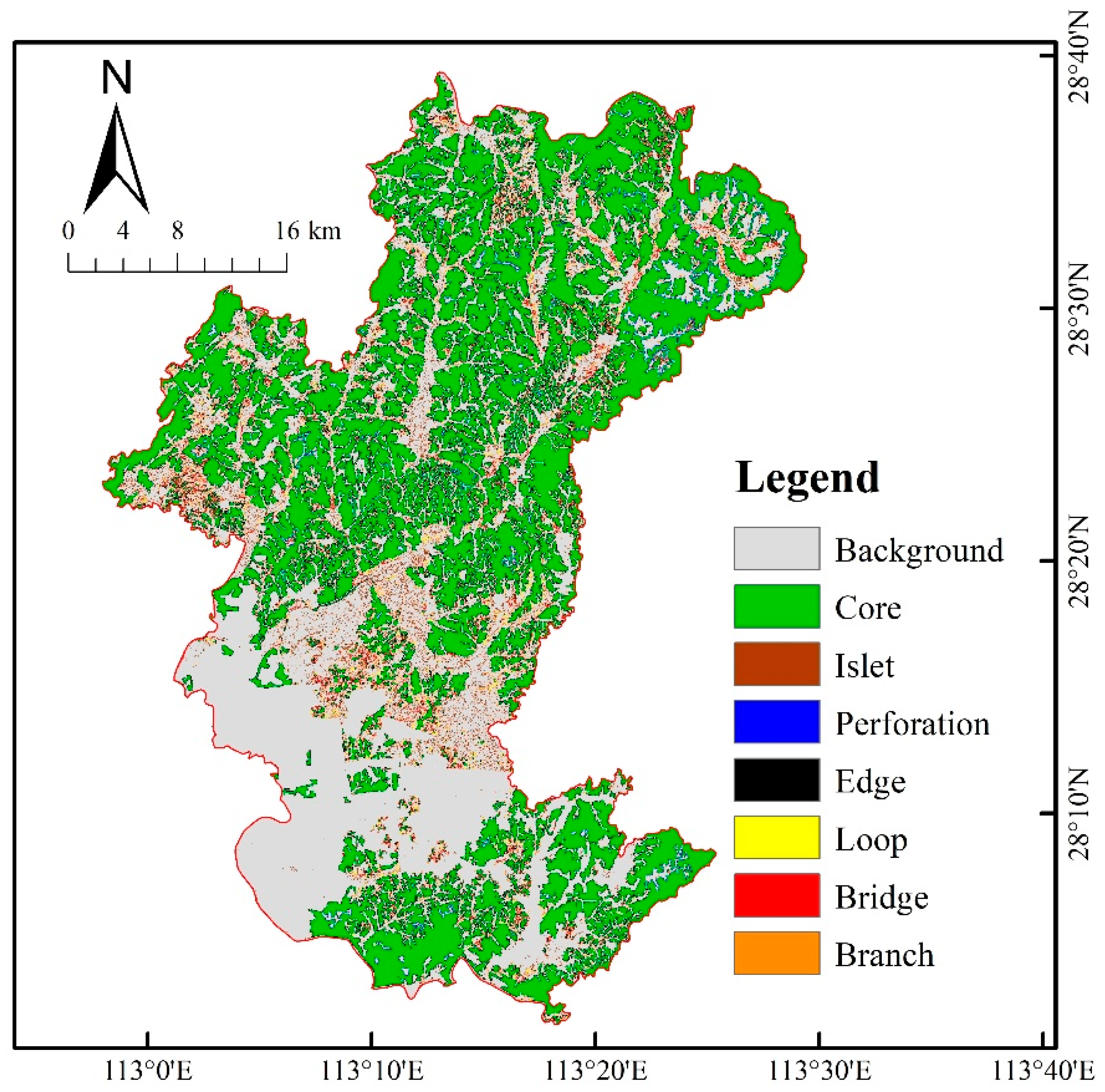
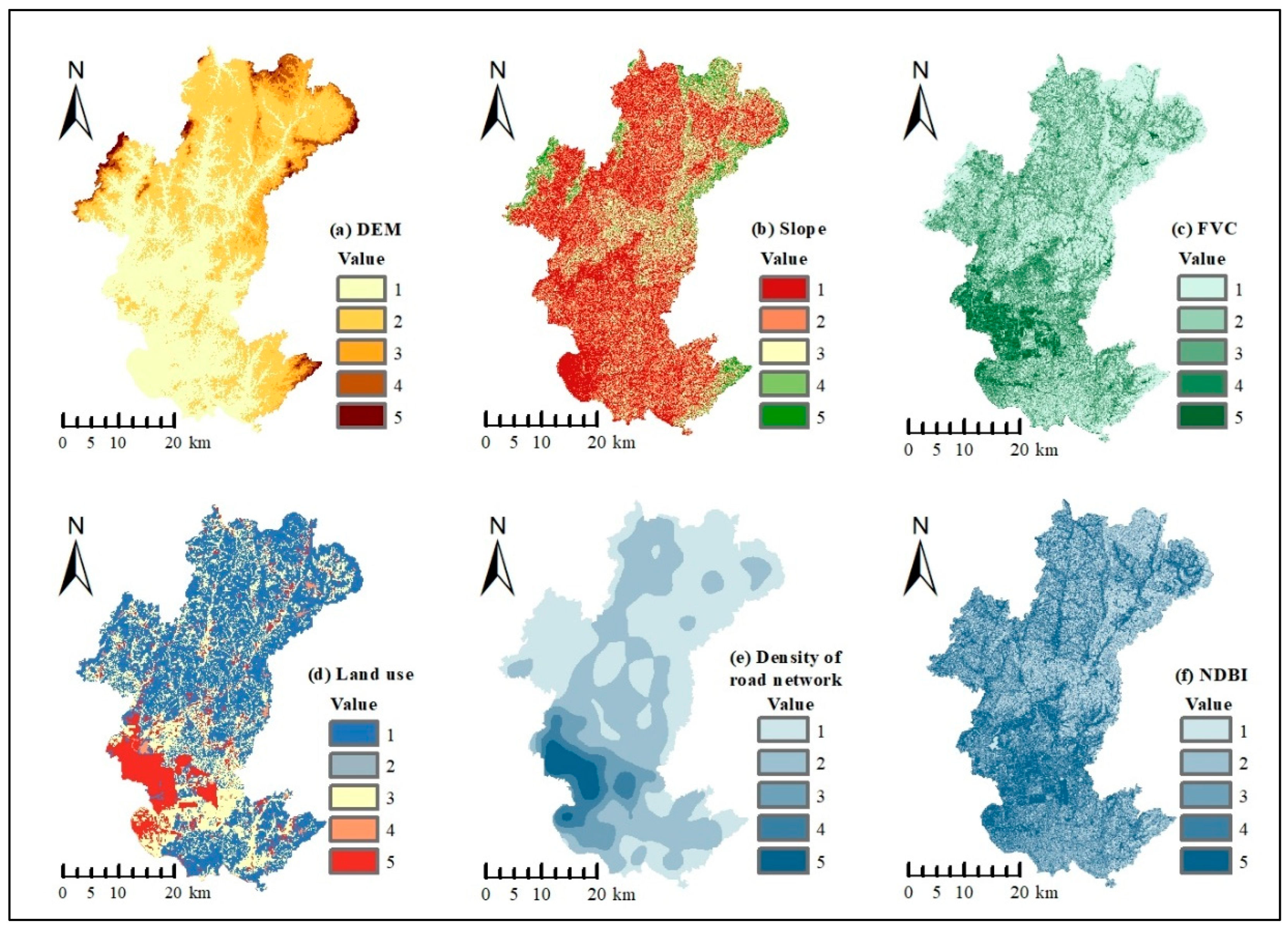
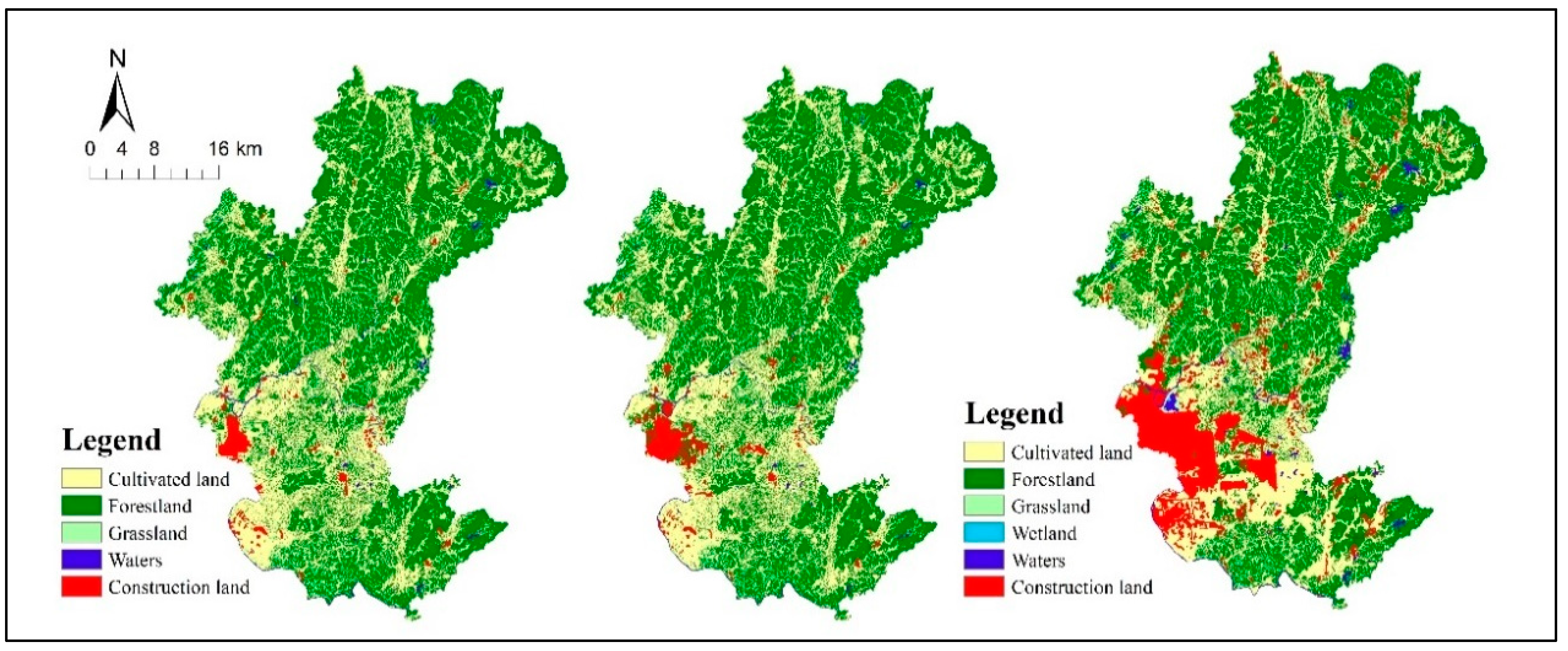
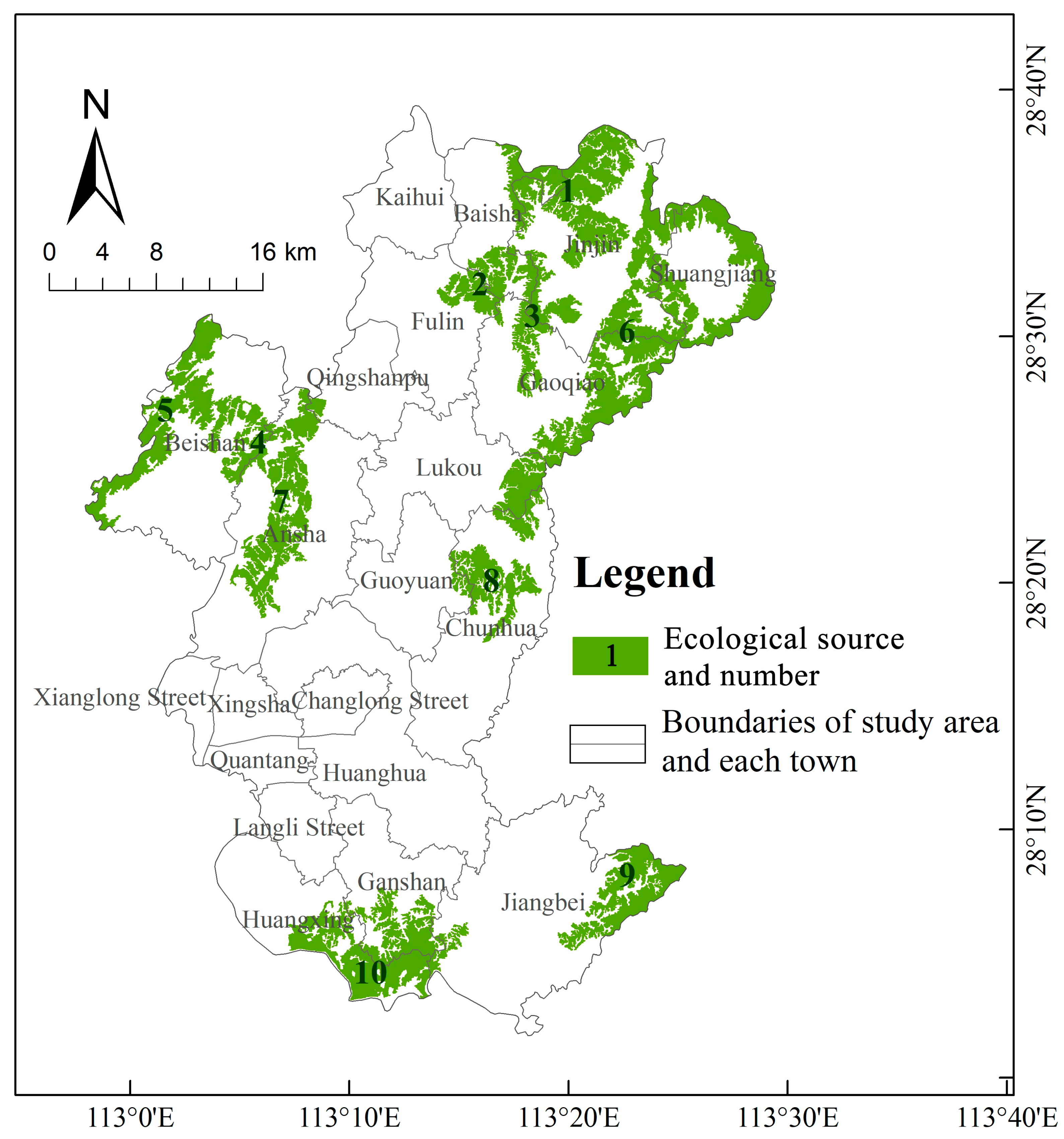

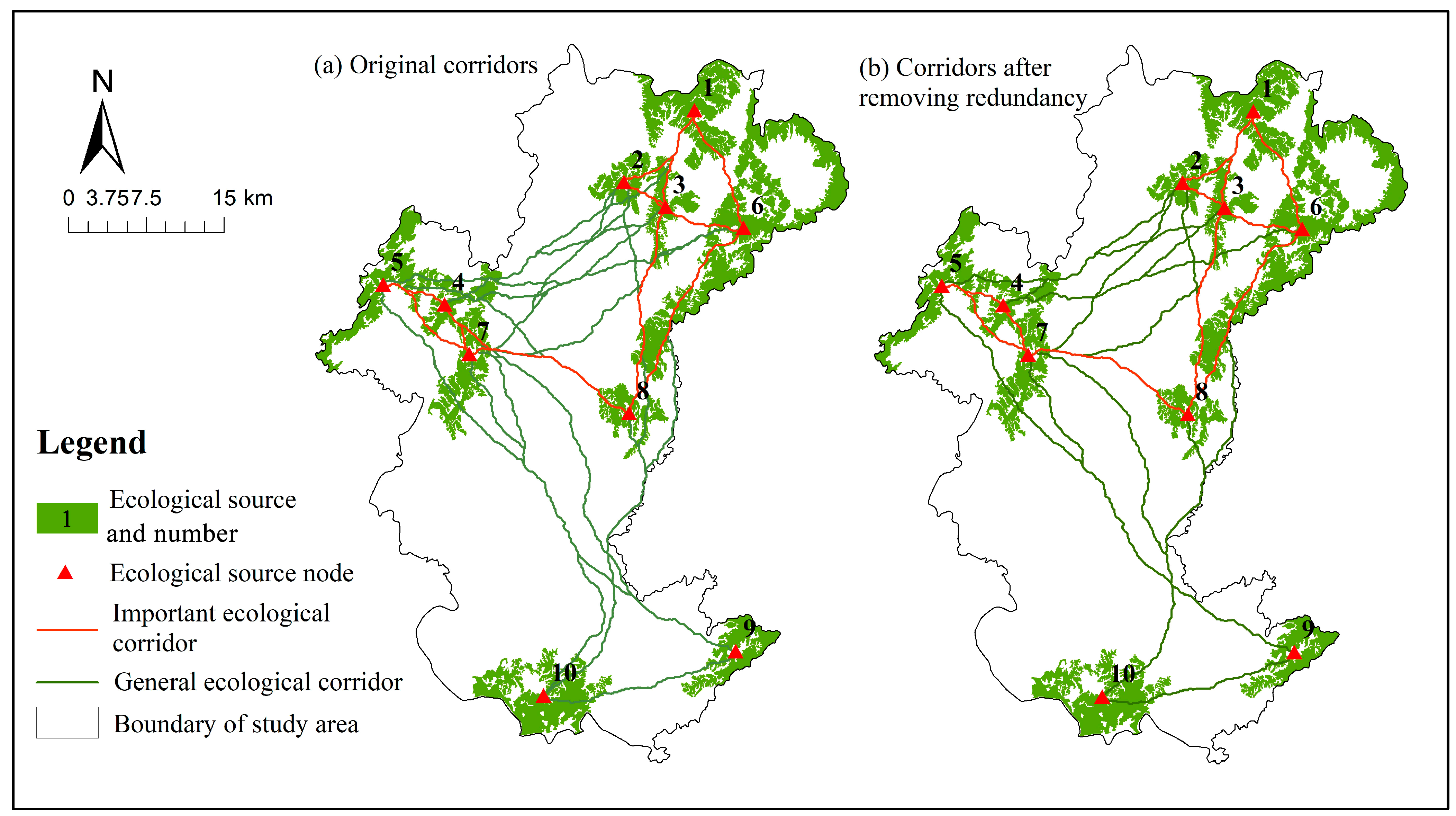
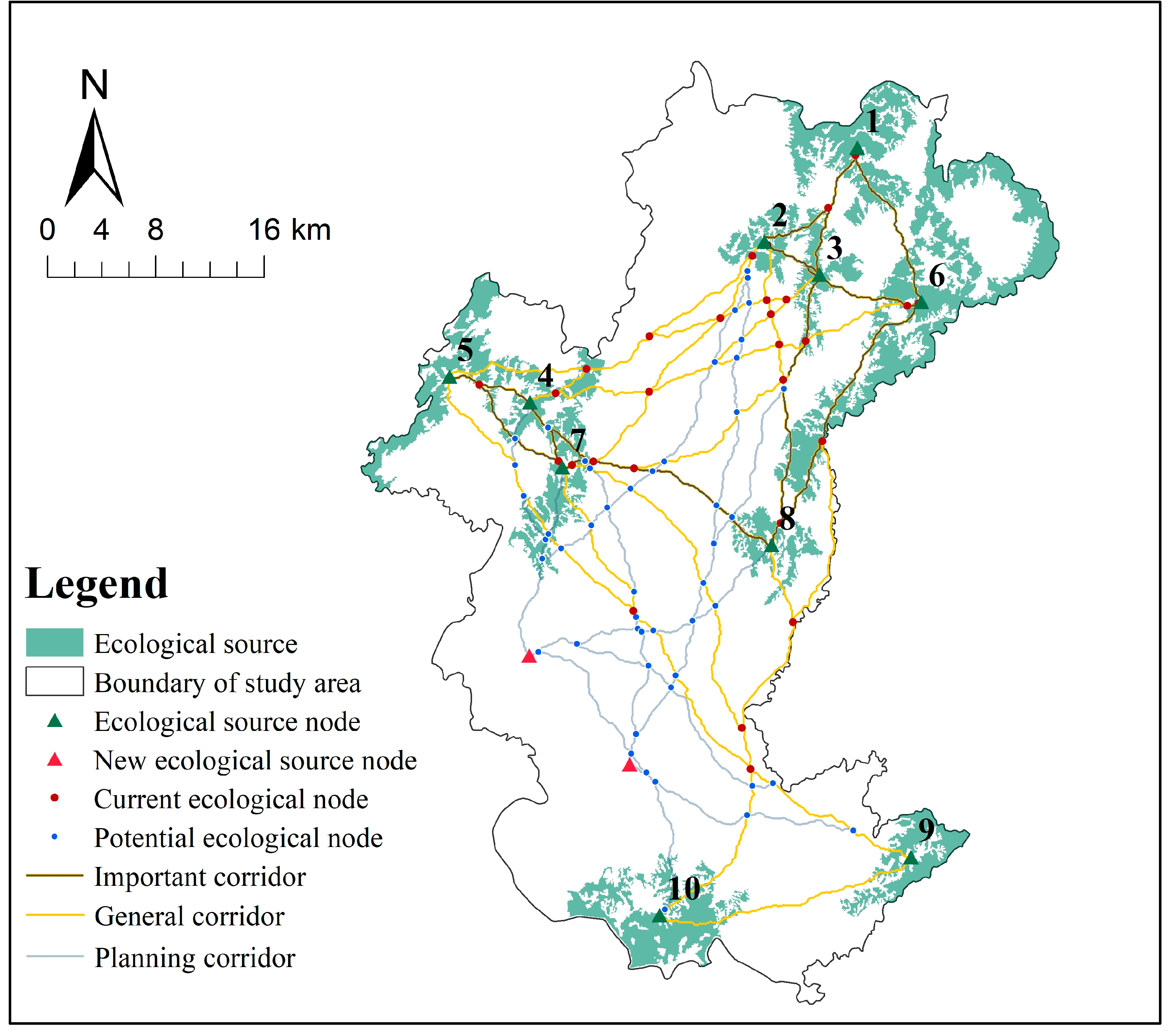

| Index Type | Rate Level | Rate Criteria | |
|---|---|---|---|
| Natural conditions | DEM (m) | 1 | <68 |
| 2 | 68~114 | ||
| 3 | 114~194 | ||
| 4 | 194~316 | ||
| 5 | 316~636 | ||
| Slope (°) | 1 | <4.64 | |
| 2 | 4.64~8.91 | ||
| 3 | 8.91~14.91 | ||
| 4 | 14.91~23.24 | ||
| 5 | 23.24~49.39 | ||
| FVC | 1 | 0.87~1 | |
| 2 | 0.72~0.87 | ||
| 3 | 0.55~0.72 | ||
| 4 | 0.35~0.55 | ||
| 5 | 0~0.35 | ||
| Landscape Type | Land cover | 1 | Forestland or grassland |
| 2 | Wetland | ||
| 3 | Cultivated land | ||
| 4 | Waters | ||
| 5 | Construction land | ||
| Human disturbance | Density of road network (km/km2) | 1 | 0~0.60 |
| 2 | 0.60~1.65 | ||
| 3 | 1.65~3.23 | ||
| 4 | 3.23~5.11 | ||
| 5 | 5.11~8.10 | ||
| NDBI | 1 | −0.96~−0.33 | |
| 2 | −0.33~−0.23 | ||
| 3 | −0.23~−0.13 | ||
| 4 | −0.13~−0.04 | ||
| 5 | −0.04~0.49 |
| Index | Components | |||||
|---|---|---|---|---|---|---|
| 1 | 2 | 3 | 4 | 5 | Weight | |
| DEM | −0.32192 | 0.180568 | 1.002822 | −0.02205 | −0.63292 | 0.05 |
| Slope | −0.35985 | 0.585116 | 1.952411 | 0.568037 | 0.74355 | 0.13 |
| FVC | 0.613611 | −0.19265 | 0.290157 | 2.554306 | −0.83085 | 0.19 |
| Land cover | 0.692215 | 1.45332 | 0.45511 | −1.22291 | −1.21825 | 0.18 |
| Density of road network | 1.571804 | −1.5705 | 1.091486 | −1.08946 | 0.590025 | 0.24 |
| NDBI | 0.39138 | 0.774361 | −0.2774 | 0.296951 | 2.834063 | 0.20 |
| Year | Land Cover | Landscape Indices | |||||
|---|---|---|---|---|---|---|---|
| CA | NP | PD | LPI | ED | SPLIT | ||
| 2000 | Cultivated land | 58,457.79 | 4870 | 2.77 | 15.90 | 95.35 | 36.34 |
| Forestland | 10,2351.4 | 18,498 | 10.53 | 17.93 | 108.06 | 21.48 | |
| Grassland | 10,362.51 | 19,050 | 10.84 | 0.11 | 37.02 | 278,873.11 | |
| Waters | 1673.64 | 374 | 0.21 | 0.06 | 2.57 | 571,426.94 | |
| Construction land | 2902.14 | 81 | 0.05 | 0.67 | 1.40 | 21,263.28 | |
| 2010 | Cultivated land | 56,585.43 | 4581 | 2.61 | 14.12 | 93.25 | 42.44 |
| Forestland | 102,913.2 | 18,813 | 10.70 | 17.96 | 109.31 | 21.36 | |
| Grassland | 10,465.56 | 19,049 | 10.84 | 0.11 | 37.28 | 269,502.17 | |
| Waters | 1368.81 | 394 | 0.22 | 0.08 | 2.63 | 538,401.68 | |
| Construction land | 4414.5 | 158 | 0.09 | 1.41 | 3.60 | 4951.10 | |
| 2020 | Cultivated land | 51,873.66 | 4521 | 2.57 | 7.08 | 76.66 | 128.65 |
| Forestland | 93,479.22 | 12,580 | 7.16 | 17.50 | 88.03 | 24.38 | |
| Grassland | 8947.44 | 16,383 | 9.32 | 0.14 | 31.32 | 196,161.31 | |
| Wetlands | 26.28 | 3 | 0.01 | 0.01 | 0.02 | 85,023,213.94 | |
| Waters | 2528.46 | 330 | 0.19 | 0.15 | 2.94 | 105,310.19 | |
| Construction land | 18,893.79 | 473 | 0.27 | 5.92 | 7.36 | 276.36 | |
| Year | Landscape Metrics | |||
|---|---|---|---|---|
| CONTAG | SPLIT | SHDI | SHEI | |
| 2000 | 52.6247 | 13.4891 | 0.96 | 0.5965 |
| 2010 | 51.782 | 14.1687 | 0.9766 | 0.6068 |
| 2020 | 53.3995 | 19.0735 | 1.1496 | 0.6416 |
| Landscape Type | Area/km2 | Proportion of Area of Prospect Data (%) | Proportion of Area of County (%) |
|---|---|---|---|
| Core | 710.30 | 69.33% | 40.42% |
| Islet | 30.88 | 3.01% | 1.76% |
| Perforation | 17.96 | 1.75% | 1.02% |
| Edge | 175.53 | 17.13% | 9.99% |
| Loop | 21.20 | 2.07% | 1.21% |
| Bridge | 27.70 | 2.70% | 1.58% |
| Branch | 40.95 | 4.00% | 2.33% |
| Total | 1024.53 | 100.00% | 58.30% |
| Number | Area/km2 | dPC |
|---|---|---|
| 6 | 91.1943 | 37.19752 |
| 7 | 28.944 | 26.82195 |
| 1 | 39.636 | 15.56345 |
| 5 | 31.068 | 10.74489 |
| 8 | 14.8131 | 10.39394 |
| 3 | 15.9048 | 7.153005 |
| 2 | 13.1463 | 7.072748 |
| 4 | 10.0629 | 6.659909 |
| 10 | 39.6117 | 2.63524 |
| 9 | 20.5335 | 2.237005 |
| Resistance Level | High | Mid-High | Mid | Mid-Low | Low |
|---|---|---|---|---|---|
| Area (km2) | 13.97 | 26.24 | 41.81 | 48.79 | 43.84 |
| Proportion (%) | 8.00 | 15.1 | 23.9 | 27.9 | 25.1 |
| Sources Number | 1 | 2 | 3 | 4 | 5 | 6 | 7 | 8 | 9 | 10 |
|---|---|---|---|---|---|---|---|---|---|---|
| 1 | 0 | 0.406 | 0.567 | 0.042 | 0.029 | 0.397 | 0.042 | 0.070 | 0.009 | 0.011 |
| 2 | 0 | 1.462 | 0.072 | 0.044 | 0.296 | 0.070 | 0.097 | 0.009 | 0.011 | |
| 3 | 0 | 0.071 | 0.044 | 1.045 | 0.075 | 0.162 | 0.012 | 0.014 | ||
| 4 | 0 | 0.764 | 0.054 | 1.271 | 0.107 | 0.010 | 0.013 | |||
| 5 | 0 | 0.035 | 0.266 | 0.058 | 0.008 | 0.010 | ||||
| 6 | 0 | 0.058 | 0.145 | 0.013 | 0.015 | |||||
| 7 | 0 | 0.165 | 0.012 | 0.015 | ||||||
| 8 | 0 | 0.022 | 0.028 | |||||||
| 9 | 0 | 0.087 | ||||||||
| 10 | 0 |
| Network 7a | Network 7b | Network 8 | |
|---|---|---|---|
| A | 2.4 | 1.1 | 1.32 |
| Β | 4.5 | 2.5 | 3.0 |
| Γ | 1.87 | 1.04 | 1.20 |
| C | 0.96 | 0.94 | 0.94 |
Disclaimer/Publisher’s Note: The statements, opinions and data contained in all publications are solely those of the individual author(s) and contributor(s) and not of MDPI and/or the editor(s). MDPI and/or the editor(s) disclaim responsibility for any injury to people or property resulting from any ideas, methods, instructions or products referred to in the content. |
© 2023 by the authors. Licensee MDPI, Basel, Switzerland. This article is an open access article distributed under the terms and conditions of the Creative Commons Attribution (CC BY) license (https://creativecommons.org/licenses/by/4.0/).
Share and Cite
Liu, S.; Xia, Y.; Ji, Y.; Lai, W.; Li, J.; Yin, Y.; Qi, J.; Chang, Y.; Sun, H. Balancing Urban Expansion and Ecological Connectivity through Ecological Network Optimization—A Case Study of ChangSha County. Land 2023, 12, 1379. https://doi.org/10.3390/land12071379
Liu S, Xia Y, Ji Y, Lai W, Li J, Yin Y, Qi J, Chang Y, Sun H. Balancing Urban Expansion and Ecological Connectivity through Ecological Network Optimization—A Case Study of ChangSha County. Land. 2023; 12(7):1379. https://doi.org/10.3390/land12071379
Chicago/Turabian StyleLiu, Shaobo, Yiting Xia, Yifeng Ji, Wenbo Lai, Jiang Li, Yicheng Yin, Jialing Qi, Yating Chang, and Hao Sun. 2023. "Balancing Urban Expansion and Ecological Connectivity through Ecological Network Optimization—A Case Study of ChangSha County" Land 12, no. 7: 1379. https://doi.org/10.3390/land12071379
APA StyleLiu, S., Xia, Y., Ji, Y., Lai, W., Li, J., Yin, Y., Qi, J., Chang, Y., & Sun, H. (2023). Balancing Urban Expansion and Ecological Connectivity through Ecological Network Optimization—A Case Study of ChangSha County. Land, 12(7), 1379. https://doi.org/10.3390/land12071379









